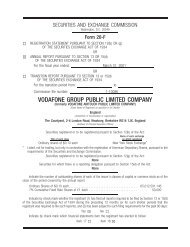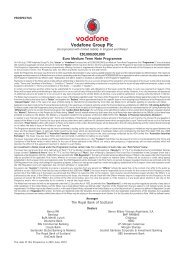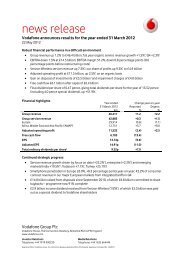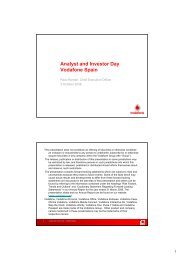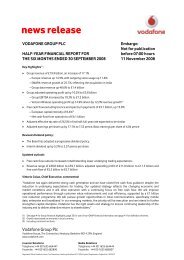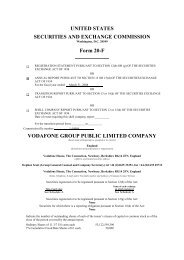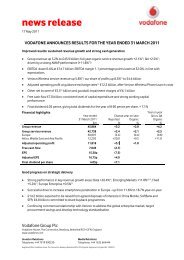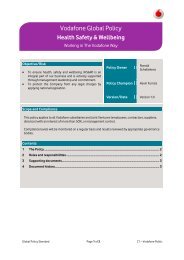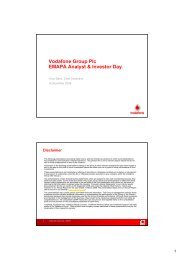Create successful ePaper yourself
Turn your PDF publications into a flip-book with our unique Google optimized e-Paper software.
<strong>Vodafone</strong> – Financials<br />
Critical Accounting Estimates continued<br />
On transition to IFRS, <strong>the</strong> Group elected not to apply IFRS 3, “Business<br />
Combinations”, retrospectively as <strong>the</strong> difficulty in applying <strong>the</strong>se requirements<br />
to <strong>the</strong> large number of business combinations completed by <strong>the</strong> Group from<br />
incorporation through to 1 April 2004 exceeded any potential benefits. Goodwill<br />
arising before <strong>the</strong> date of transition to IFRS, after adjusting for items including<br />
<strong>the</strong> impact of proportionate consolidation of joint ventures, amounted to<br />
£78,753 million.<br />
If <strong>the</strong> Group had elected to apply <strong>the</strong> accounting for business combinations<br />
retrospectively, it may have led to an increase or decrease in goodwill and<br />
increase in licences, customer bases, brands and related deferred tax liabilities<br />
recognised on acquisition.<br />
Intangible assets, excluding goodwill<br />
O<strong>the</strong>r intangible assets include <strong>the</strong> Group’s aggregate amounts spent on <strong>the</strong><br />
acquisition of 2G and 3G licences, computer software, customer bases, brands and<br />
development costs. These assets arise from both separate purchases and from<br />
acquisition as part of business combinations.<br />
The relative size of <strong>the</strong> Group’s intangible assets, excluding goodwill, makes <strong>the</strong><br />
judgements surrounding <strong>the</strong> estimated useful lives critical to <strong>the</strong> Group’s financial<br />
position and performance.<br />
At 31 March 2008, intangible assets, excluding goodwill, amounted to £18,995<br />
million (2007: £15,705 million) and represented 14.9% (2007: 14.3%) of <strong>the</strong><br />
Group’s total assets.<br />
Estimation of useful life<br />
The useful life used to amortise intangible assets relates to <strong>the</strong> future performance<br />
of <strong>the</strong> assets acquired and management’s judgement of <strong>the</strong> period over which<br />
economic benefit will be derived from <strong>the</strong> asset. The basis for determining <strong>the</strong><br />
useful life for <strong>the</strong> most significant categories of intangible assets is as follows:<br />
Licences and spectrum fees<br />
The estimated useful life is, generally, <strong>the</strong> term of <strong>the</strong> licence, unless <strong>the</strong>re is a<br />
presumption of renewal at negligible cost. Using <strong>the</strong> licence term reflects <strong>the</strong><br />
period over which <strong>the</strong> Group will receive economic benefit. For technology<br />
specific licences with a presumption of renewal at negligible cost, <strong>the</strong> estimated<br />
useful economic life reflects <strong>the</strong> Group’s expectation of <strong>the</strong> period over which <strong>the</strong><br />
Group will continue to receive economic benefit from <strong>the</strong> licence. The economic<br />
lives are periodically reviewed, taking into consideration such factors as changes<br />
in technology. Historically, any changes to economic lives have not been material<br />
following <strong>the</strong>se reviews.<br />
Customer bases<br />
The estimated useful life principally reflects management’s view of <strong>the</strong> average<br />
economic life of <strong>the</strong> customer base and is assessed by reference to customer<br />
churn rates. An increase in churn rates may lead to a reduction in <strong>the</strong> estimated<br />
useful life and an increase in <strong>the</strong> amortisation charge. Historically, changes to <strong>the</strong><br />
estimated useful lives have not had a significant impact on <strong>the</strong> Group’s results and<br />
financial position.<br />
86 <strong>Vodafone</strong> Group Plc Annual Report 2008<br />
Capitalised software<br />
The useful life is determined by management at <strong>the</strong> time <strong>the</strong> software is acquired<br />
and brought into use and is regularly reviewed for appropriateness. For computer<br />
software licences, <strong>the</strong> useful life represents management’s view of expected<br />
benefits over which <strong>the</strong> Group will receive benefits from <strong>the</strong> software, but not<br />
exceeding <strong>the</strong> licence term. For unique software products controlled by <strong>the</strong> Group,<br />
<strong>the</strong> life is based on historical experience with similar products as well as anticipation<br />
of future events, which may impact <strong>the</strong>ir life, such as changes in technology.<br />
Historically, changes in useful lives have not resulted in material changes to <strong>the</strong><br />
Group’s amortisation charge.<br />
Property, plant and equipment<br />
Property, plant and equipment also represent a significant proportion of <strong>the</strong> asset<br />
base of <strong>the</strong> Group, being 13.1% (2007: 12.3%) of <strong>the</strong> Group’s total assets. Therefore,<br />
<strong>the</strong> estimates and assumptions made to determine <strong>the</strong>ir carrying value and related<br />
depreciation are critical to <strong>the</strong> Group’s financial position and performance.<br />
Estimation of useful life<br />
The charge in respect of periodic depreciation is derived after determining an<br />
estimate of an asset’s expected useful life and <strong>the</strong> expected residual value at <strong>the</strong><br />
end of its life. Increasing an asset’s expected life or its residual value would result<br />
in a reduced depreciation charge in <strong>the</strong> Consolidated Income Statement.<br />
The useful lives of Group assets are determined by management at <strong>the</strong> time <strong>the</strong><br />
asset is acquired and reviewed annually for appropriateness. The lives are based<br />
on historical experience with similar assets as well as anticipation of future events,<br />
which may impact <strong>the</strong>ir life, such as changes in technology. Fur<strong>the</strong>rmore, network<br />
infrastructure is only depreciated over a period that extends beyond <strong>the</strong> expiry<br />
of <strong>the</strong> associated licence under which <strong>the</strong> operator provides telecommunications<br />
services, if <strong>the</strong>re is a reasonable expectation of renewal or an alternative future use<br />
for <strong>the</strong> asset.<br />
Historically, changes in useful lives have not resulted in material changes to <strong>the</strong><br />
Group’s depreciation charge.<br />
Cost capitalisation<br />
Cost includes <strong>the</strong> total purchase price and labour costs associated with <strong>the</strong><br />
Group’s own employees to <strong>the</strong> extent that <strong>the</strong>y are directly attributable to<br />
construction costs, or where <strong>the</strong>y comprise a proportion of a department directly<br />
engaged in <strong>the</strong> purchase or installation of a fixed asset. Management judgement<br />
is involved in determining <strong>the</strong> appropriate internal costs to capitalise and <strong>the</strong><br />
amounts involved. For <strong>the</strong> year ended 31 March 2008, internal costs capitalised<br />
were £245 million (2007: £244 million) and represented approximately 5% (2007:<br />
6%) of expenditure on property, plant and equipment and computer software.




